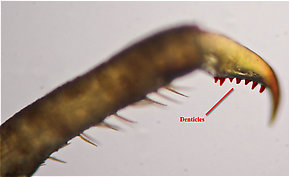Blog & Latest Updates
Fly Fishing Articles
Insects by Common Name


Mayfly Genus Serratella
Taxonomic Navigation -?-
Kingdom
Animalia (Animals)
» Phylum
Arthropoda (Arthropods)
» Class
Insecta (Insects)
» Order
Ephemeroptera (Mayflies)
» Genus Serratella
| Species in Serratella | ||
| Serratella micheneriLittle Western Dark Hendrickson | 0 | 0 |
| Serratella serrataLittle Sooty Olive | 0 | 0 |
5 species aren't included.
These changes have had an even bigger impact in the West. The significant Summer hatching tibialis has been moved back to its old genus and is again called Ephemerella tibialis (Small Western Dark Hendrickson). The next most prominent species (though of only minor importance) is now called Matriella teresa and is the only recognized species of that genus in North America. The very minor species velmae has also been moved, and is now back in Ephemerella. This leaves only a few western species in this genus, and they are of no reported significance to anglers.
Pictures of 3 Mayfly Specimens in the Genus Serratella:
Serratella micheneri (Little Western Dark Hendrickson) Mayfly Nymph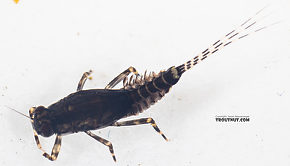 View 6 Pictures
View 6 Pictures
 View 6 Pictures
View 6 PicturesCollected July 28, 2019 from Mystery Creek #199 in Washington
Added to Troutnut.com by Troutnut on July 30, 2019
Added to Troutnut.com by Troutnut on July 30, 2019
Male Serratella micheneri (Little Western Dark Hendrickson) Mayfly Nymph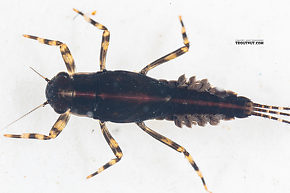 View 9 PicturesThis specimen has tarsal claws (Tarsal claw: The claws at the tip of the tarsus, on an insect's "foot.") with 7 denticles (Denticle: Small tooth-like projects, often appearing like serrations on the tarsal claws of certain mayfly nymphs.) and tubercles (
View 9 PicturesThis specimen has tarsal claws (Tarsal claw: The claws at the tip of the tarsus, on an insect's "foot.") with 7 denticles (Denticle: Small tooth-like projects, often appearing like serrations on the tarsal claws of certain mayfly nymphs.) and tubercles (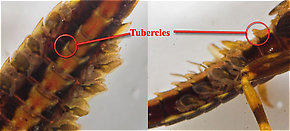 Tubercle: Various peculiar little bumps or projections on an insect. Their character is important for the identification of many kinds of insects, such as the nymphs of Ephemerellidae mayflies.) on abdominal segments 4-7 only. It keys to Serratella micheneri, as do some other specimens from the same collection that lacked the dorsal (Dorsal: Top.) stripe.
Tubercle: Various peculiar little bumps or projections on an insect. Their character is important for the identification of many kinds of insects, such as the nymphs of Ephemerellidae mayflies.) on abdominal segments 4-7 only. It keys to Serratella micheneri, as do some other specimens from the same collection that lacked the dorsal (Dorsal: Top.) stripe.
 View 9 PicturesThis specimen has tarsal claws (Tarsal claw: The claws at the tip of the tarsus, on an insect's "foot.") with 7 denticles (Denticle: Small tooth-like projects, often appearing like serrations on the tarsal claws of certain mayfly nymphs.) and tubercles (
View 9 PicturesThis specimen has tarsal claws (Tarsal claw: The claws at the tip of the tarsus, on an insect's "foot.") with 7 denticles (Denticle: Small tooth-like projects, often appearing like serrations on the tarsal claws of certain mayfly nymphs.) and tubercles (
A few (not all) of the abdominal tubercles on this Ephemerella needhami nymph are circled. They are especially large in this species.
Collected July 28, 2019 from Mystery Creek #199 in Washington
Added to Troutnut.com by Troutnut on July 30, 2019
Added to Troutnut.com by Troutnut on July 30, 2019
Serratella micheneri (Little Western Dark Hendrickson) Mayfly Nymph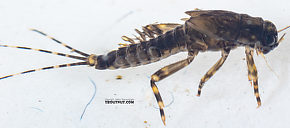 View 6 Pictures
View 6 Pictures
 View 6 Pictures
View 6 PicturesCollected July 28, 2019 from Mystery Creek #199 in Washington
Added to Troutnut.com by Troutnut on July 30, 2019
Added to Troutnut.com by Troutnut on July 30, 2019
Recent Discussions of Serratella
Flightless Mayfly?? 8 Replies »
In "Splitting Cane", Ed Engle refers to the "elusive flightless Serratella mayfly" - does anyone know if this was a joke, or if there is such a thing? "Mayflies" by Knopp & Cormier certinaly does not mention such a beast.
Thanks
ReplyLearning to Use the Force 6 Replies »Thanks
Went over to the Dark Side the past two days. Thanks to all who helped. By the way, Jason, fished spinners also.
ReplyEmerger 6 Replies »Does anyone know the color of the emerging/freshly emerged dun?
ReplySerratella 1 Reply »Jason: I was fishing in Central PA with a buddy on Sunday and we collected 2 different BWO species from the water. A really small one, about 22 to 24, had an olive/gray body. The other, which was about a size 20, had a gray body and thorax and was matched well with natural beaver fur. I don't know the names, of course, but I saw them with my own eyes. We did well fishing an emerger/dun pattern in sizes 20 and 22. We tied some with trailing shucks of amber or dun. We used a light olive thread for the body, sparse gray beaver dubbing for the thorax, and dun snow shoe for the wing.
ReplyYour Thoughts On Serratella:
Top 10 Fly Hatches
Top Gift Shop Designs
Eat mayflies.
Top Insect Specimens
Miscellaneous Sites
Troutnut.com is copyright © 2004-2024 Jason
Neuswanger (email Jason). See my FAQ for information about use of my images.
 privacy policy
privacy policy

